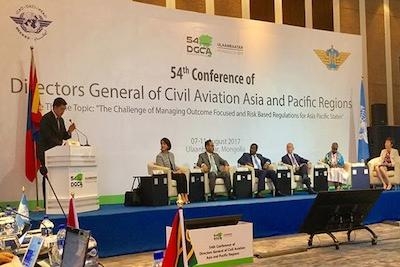Thu, Aug 10, 2017
Huerta: Safety Has No Borders
FAA Administrator Michael P. Huerta, speaking at an Asia-Pacific civil aviation conference in Mongolia, said that the FAA and its Asia-Pacific counterparts must continue to work together to promote oversight operations and certification systems that will ensure the safety of passengers around the world as demand increases.

The FAA projects that within 20 years, the total number of passengers traveling between the Asia-Pacific region and the U.S. alone will increase by 120 percent.
“By sharing data and best practices with each other, we’ve proven that safety has no borders,” said Huerta. “It is imperative that we work together to meet this increased demand and deliver the level of safety and service consumers and businesses on both sides of the Pacific expect.”
Aviation leaders gathered at the Asia-Pacific Directors General of Civil Aviation Conference to discuss the future of civil aviation in the Asia-Pacific region. The U.S. has collaborated with the region since establishing a civil aviation office in Tokyo in 1947.
In cooperation with forums such as the Asia-Pacific Economic Cooperation (APEC) and the Association of Southeast Asian Nations (ASEAN), FAA is working to improve air traffic efficiency in the region. For example, through engagement with ASEAN, FAA is working to emphasize the operational value of cross-border data information sharing between Asian states.
With APEC, the FAA is standardizing and implementing innovative traffic flow management technologies and best practices to allow for separation reductions and smoother traffic flow. The FAA also is supporting regional initiatives to implement more Performance-Based Navigation procedures, which shorten flight routes, save time, and reduce emissions.
Leaders of both regions committed to improving the efficiency of each nation’s aviation systems in a time when new technologies continue to reshape traditional aircraft and air traffic operations.
(Image provided with FAA news release)
More News
Airport Marking Aids Markings used on runway and taxiway surfaces to identify a specific runway, a runway threshold, a centerline, a hold line, etc. A runway should be marked in ac>[...]
"It is extremely difficult, if not impossible, for manned aircraft to see a drone while conducting crop-enhancing and other aerial applications at low altitudes and high speeds. We>[...]
Aero Linx: The Skyhawk Association The Skyhawk Association is a non-profit organization founded by former Skyhawk Pilots which is open to anyone with an affinity for the A-4 Skyhaw>[...]
“The T-54A benefits from an active Beechcraft King Air assembly line in Wichita, Kansas, where all required METS avionics and interior modifications are installed on the line>[...]
Aero Linx: Aerostar Owners Association The Association offers the Aerostar Owner a unique opportunity to tap an invaluable source of information concerning the care and feeding of >[...]
 ANN's Daily Aero-Term (04.28.24): Airport Marking Aids
ANN's Daily Aero-Term (04.28.24): Airport Marking Aids Aero-News: Quote of the Day (04.28.24)
Aero-News: Quote of the Day (04.28.24) ANN's Daily Aero-Linx (04.28.24)
ANN's Daily Aero-Linx (04.28.24) Aero-News: Quote of the Day (04.29.24)
Aero-News: Quote of the Day (04.29.24) ANN's Daily Aero-Linx (04.29.24)
ANN's Daily Aero-Linx (04.29.24)



